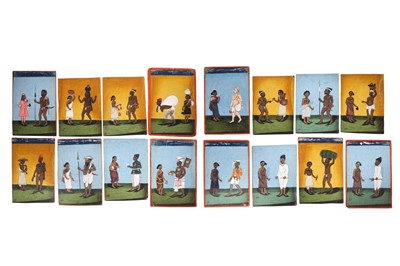13th Jul, 2022 13:00
A Middle Eastern Journey
SIXTEEN SOUTH INDIAN PAINTINGS OF PAIRS OF LOCAL VILLAGERS, TRADESPEOPLE, AND RELIGIOUS DEVOTEES
Tanjore (Thanjavur) Company School, Tamil Nadu, South India, ca. 1780 - 1800
SIXTEEN SOUTH INDIAN PAINTINGS OF PAIRS OF LOCAL VILLAGERS, TRADESPEOPLE, AND RELIGIOUS DEVOTEES
Tanjore (Thanjavur) Company School, Tamil Nadu, South India, ca. 1780 - 1800
Opaque pigments heightened with gold on thick buff paper, comprising sixteen vertical compositions once part of a South Indian Company School album collecting images of local villagers, their attires, skin tones, and daily habits, each album page depicting a standing pair of Indian people including a Shaiva ascetic, a water carrier, a basket maker, a woodcutter, a member of the kshatriya caste (soldier), a messenger, a priest, a farmer, a merchant and more, the attires of their female counterparts indicative of their caste and status, each one wearing several personal accessories including golden bangles, some with pearls and coral beads, bejewelled gold necklaces, and pairs of heavily encrusted gold earrings, the fashion of each pair following Southern Indian standards, most pages set within burgundy rules and bright orange borders, other pages trimmed, each page with an Arabic numeral in black ink on the lower-left corner from no. 2 to no. 47 in random sequence supporting the suggestion of the compositions being part of a Company School album made for the Western market, the largest 31.5cm x 22cm.
The term ‘Company Painting’ has been used by Indian art historians to denote a special kind of 18th and 19th-century Indian painting production, mainly deriving from the colonial and commercial connection established with Western countries like Britain, France, and the Netherlands (Mildred Archer, Company Drawings in the India Office Library, 1972, p. 1). This genre started in the South of India; it then moved to the East, mostly Calcutta and Murshidabad; and it finally reached the North creating a large centre of production in Delhi.
In her monograph, Company Drawings in the India Office Library, Mildred Archer identifies three albums similar to ours once part of the India Office Library and attributes them all to the late 18th-century Company School of Tanjore in Tamil Nadu (Ibidem, p. 21). Among the quintessential features of this school's genre, one can count large-scale sets of a recurrent subject, namely a man and a woman of various castes standing side by side holding the implements of their occupation; the use of a very bright and gaudy palette for both the subjects and the backgrounds; and an odd use of shadows, mostly in the form of black curved 'slippers' attached to the feet of the sitters. From 1800 onward, Archer denotes a stronger European influence, leading to plainer backgrounds; a more muted palette; the use of European paper; and the preference for watercolour instead of gouache, placing our album in the 1780 - 1800 period.
Sold for £10,000
Includes Buyer's Premium
Do you have an item similar to the item above? If so please click the link below to submit a free online valuation request through our website.


